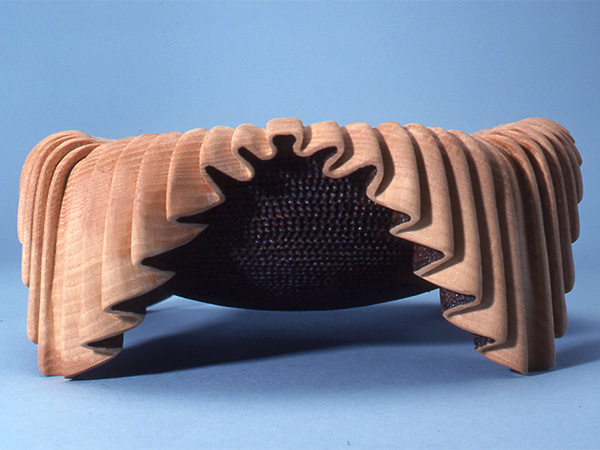
Working mostly with burls harvested around her Vermont home, Michelle Holzapfel is recognized for her detailed, finely turned, and carved pieces. Often starting out as a simple vase or classical amphora, her work may incorporate mythic figures and images from a wide variety of sources and personal themes.
When asked what she does, Michelle usually explains that she’s a woodcarver or a woodworker. If pressed for more information, she might add that she makes vessel forms. But she doesn’t think her work fits into a firm category. And even with her work now featured in several fine art galleries and private collections, the title “sculptor” conjures up the wrong image and is too far afield from what she does.
How she does what she does, was greatly influenced by growing up in a family with six kids. Her father, a tool and die maker, taught her about tools and problem solving. From her mother, a seamstress, she learned that doing something by hand puts information into your fingers. In high school art classes, she experimented with linoleum prints, then woodblocks, eventually discovering that she enjoyed the woodcarving more than the printing. Though she started college, marriage and children (sons arriving in 1972 and 1974) sidetracked her after a year.
By 1976, she and her husband David were ready to start a woodworking business. With neither having much experience, they bought the business of an old woodworker David had worked for during college. With his inventory (mostly slabs of diagonal cut butternut) and tools (big, heavy, and commercial), they set up shop in the three bay garage that came with their house. Coinciding with the beginning of a new craft movement, Michelle became interested in turning. She got a few books and taught herself to turn. About the same time, the couple began to get piles of burl from loggers who considered them to be useless leftovers.
“I started making simple little turned forms, and within a couple of years, once I got my technique down, I got a little bored with just polished surfaces,” Michelle recalled. “At the shows there were always plenty of spalted, thin-walled vessels, and the repetition didn’t interest me. That’s when I remembered I liked to carve and I started carving, in a modest way, into the surface of the turned forms.”
As her style developed, attending craft shows became increasingly frustrating.
“I’d have my stuff on display and people would like it, but never buy,” She explained. “And the more carving I did, the more time it took, and the more I had to charge. I never sold anything, and then I’d see these carved decoys, slavishly reproduced feather-by-feather, and folk carvings selling hand over fist. As much as I like to think of myself as an artist who didn’t care about the marketplace, it made me kind of bitter.”
Over time, her husband developed a form of arthritis, had to discontinue full-time woodworking, and go into teaching. But Michelle’s work, despite its lack of commercial success, continued to evolve. Carving took over the lion-share of her interests & and turning comprised only a tenth of the time spend on an average piece. Persevering over the next 20 years, her work eventually became accepted in galleries and by gallery patrons.
Today, a large metal turning lathe, inherited from her father, takes some of the wear-and-tear out of cutting through hard and irregular burl wood. Her carving tools include an electric chain saw for roughing out, an air-powered die grinder for carving, and an air-powered pencil grinder (“It looks like a dentist’s drill”) for fine work. Her favorite wood is cherry burl, though she enjoys working with other southern Vermont hardwoods. If something is really complex, she may use a simpler grain that won’t compete with the carving. For sanding or smoothing, she’ll use everything from disks and wheels to orbital sanders and scrapers.
“I very rarely use stain, it looks so cheesy, like hair dye gone wrong,” she noted. “I might stipple it to give it a dark surface. If there’s a part of the wood that’s soft or punky, I’ll use Solar Lux stain to even it up. For a finish, I’ll put on a coat of Watco, then depending on the porosity of the wood, two to three coats of Minwax antique oil finish.”
So why all the vessels and vases in her recent work?
“I’ve always been kind of an independent scholar. I didn’t get my BA until 1995 after the kids were in college, but I did lots of reading and writing, went to museums, and just kept my eyes open. Though it really doesn’t show up in my work, I’ve been influenced by a lot of African ceremonial carvings — masks, bowls, and spoons — they’re so grounded in the wood they’re made from. I’ve also had strong feelings when I’ve looked at Chinese bronzes and the devotional lime wood carvings done during the German renaissance.”
“Limiting my work to the vessel form aligns me with my influences,” She explained. “I like working within a parameter and I’ve stuck with the vessel form. And I’d rather deal with a hundred possibilities than thousands.”
She keeps a backlog of ideas and images. As she approaches the woodpile, she may be looking for just the right wood for one of her ideas. But since the wood has its own structure, say a big cleft or bark seam, she modifies her idea to work with the physical qualities of the wood. The results are often better than her original plan, plus, she says, it usually opens up even more ideas for the next piece.





